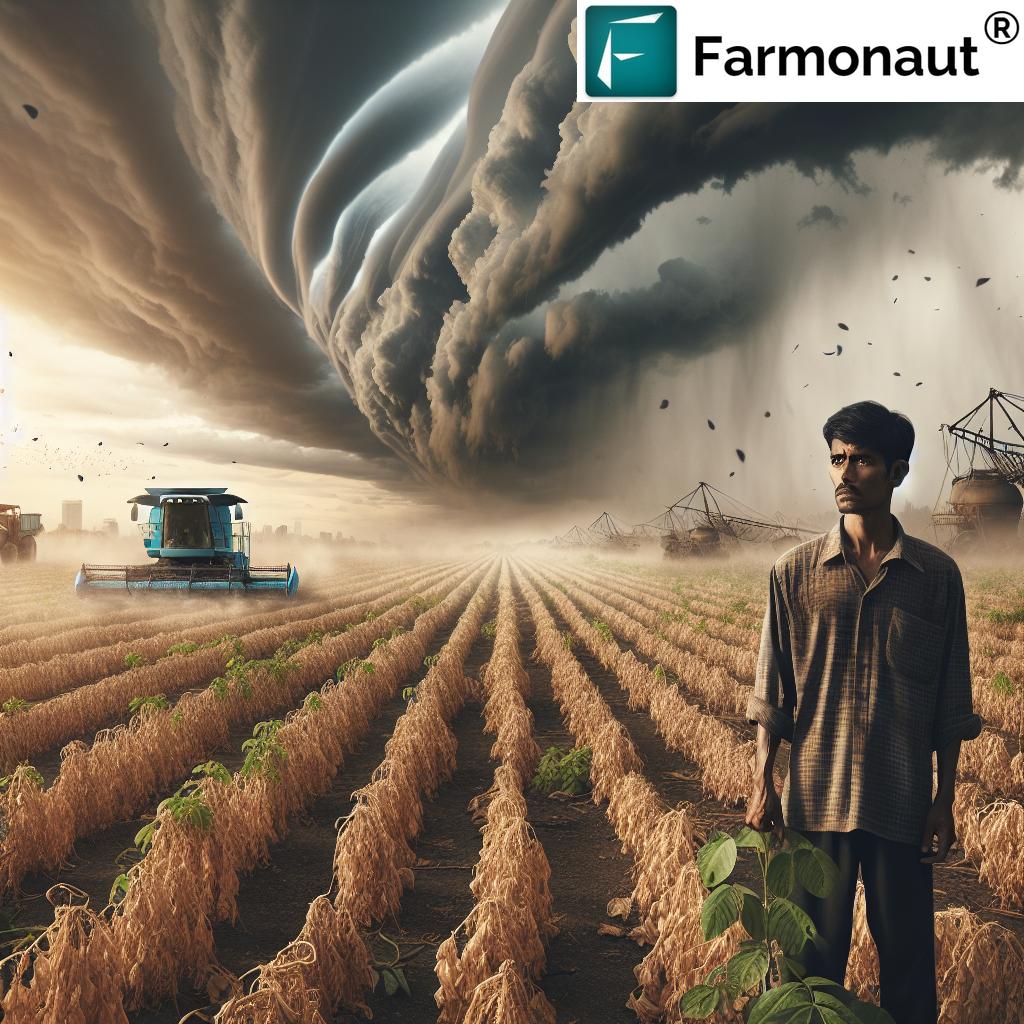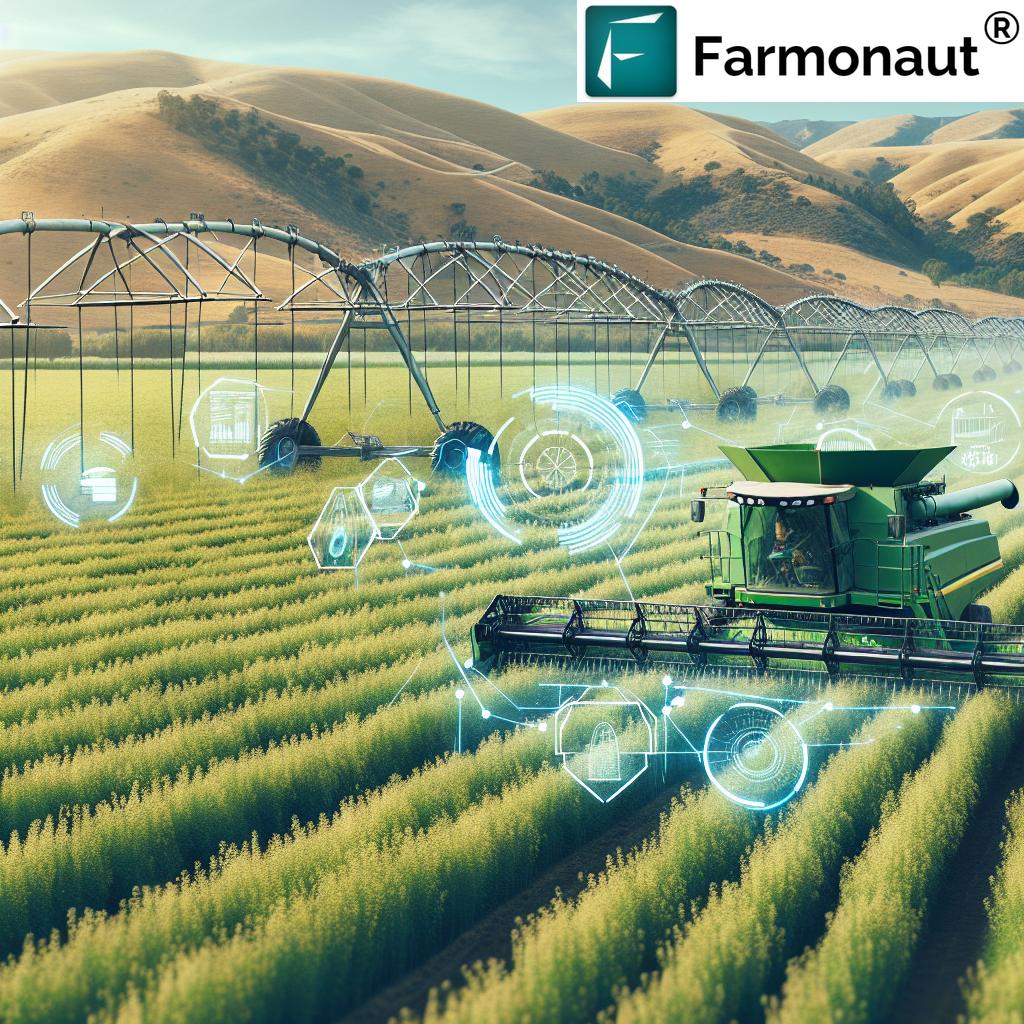Are American Farmers Struggling? 7 Urgent Challenges in 2025
“In 2025, U.S. farm labor shortages reached a 20-year high, impacting over 60% of large-scale producers.”
Table of Contents
- Summary of the Multifaceted Crisis
- 1. Economic Challenges in Agriculture
- 2. Agricultural Labor Shortages & Workforce Dynamics
- 3. Agriculture Policy Uncertainty & Farm Worker Immigration Issues
- 4. Environmental Challenges in Agriculture
- 5. The Mental Health Crisis in Farming
- 6. Technological Issues & Agriculture Supply Chain Disruptions
- Comparison Table of Key Challenges Facing American Farmers in 2025
- How Farmonaut Empowers Agriculture with Technology & Data
- Frequently Asked Questions
- Conclusion: The Future of U.S. Agriculture
Focus Keyword: Are American Farmers Struggling
American Farmers: Confronting a Multifaceted Crisis in 2025
The U.S. agricultural sector stands at a crossroads in 2025. American farmers are facing unprecedented challenges — from agricultural labor shortages, economic pressures, policy uncertainty, environmental threats, to a mounting mental health crisis. These intertwined crises not only threaten the viability and sustainability of farmers and the entire agricultural system, but also put the nation’s food supply chain at risk. Understanding the depth, causes, and repercussions of these issues is essential for all stakeholders interested in the resilience and future of American farming.
This article offers a comprehensive analysis of the challenges facing American farmers in 2025 — combining the latest data, industry trends, and expert insights. We explore seven urgent issues defined by labor instability, rising costs, policy flux, environmental adversity, technological hurdles, supply chain disruptions, and the mental strain on our agricultural communities.
1. Economic Challenges in Agriculture: Rising Costs, Squeezed Margins
The economic challenges in agriculture are at the forefront of the multifaceted crisis for American farmers in 2025. Deteriorating profit margins, volatile commodity prices, and rising production costs continue to apply significant financial strain across the sector.
Key Issues: Fluctuations, Escalating Costs, and Shrinking Margins
- Rising Expenses: American farmers saw a stunning 15% increase in input costs in 2025, encompassing essential fertilizers, seeds, fuel, and equipment. This inflation has affected farms of all sizes, threatening especially small and mid-sized operations.
- Commodity Price Fluctuations: Global market instability — fueled by war, trade tensions, climate events, and policy shifts — causes wild swings in crop prices. When prices drop and input costs rise, farm profit margins are further compressed.
- Access to Credit & Financing: With profit uncertainty, agricultural lenders are tightening loan standards and increasing underwriting requirements. Even established farmers face heightened scrutiny and shorter loan terms.
- Financial Strain & Viability: The result is increased anxiety over credit quality deterioration and financial sustainability. Farmers frequently delay upgrades and input purchasing due to cash flow concerns, slowing innovation and placing long-term viability at risk.
This cumulative economic strain threatens not just individual farms but the competitiveness of the broader American agricultural sector.
Farmonaut Tools for Financial Sustainability
We at Farmonaut offer advanced solutions that help optimize production and improve resource management. Our Large-Scale Farm Management Tools enable growers to make data-driven decisions on when and how much to irrigate or fertilize, directly aiding in input cost reduction and yield improvement. For those focused on sustainability and compliance, our Carbon Footprinting Solution offers real-time tracking of emissions, supporting both environmental objectives and consumer requirements.
“American farmers faced a 15% increase in input costs in 2025, straining profit margins across the industry.”
2. Agricultural Labor Shortages & Workforce Dynamics
The issue of agricultural labor shortages in the U.S. is now reaching crisis levels, especially for crops requiring manual harvesting. The workforce is both aging and shrinking, with immigration policies and demographic shifts compounding the scarcity of farmworkers.
The Roots and Realities of Labor Shortages
- Aging Farmer Population: The average age of American farmers is approaching 60. With fewer young workers entering the field, the pipeline of new agricultural talent is drying up.
- Immigration and Workforce Policies: The H-2A Temporary Agricultural Worker program has expanded dramatically, but is still plagued by bureaucratic delays and process inefficiencies. These issues have left many farms without sufficient labor during critical planting and harvest windows.
- Stringent Immigration Policies: Restrictive and inconsistent immigration enforcement has dissuaded both potential workers and agri-business investment, contributing further to temporary worker shortages.
- Regional and Crop-Specific Struggles: Labor shortages are especially acute in fruit/vegetable production regions like California’s Central Valley and the Southeast, where a significant portion of farmworkers traditionally lack legal authorization.
These labor challenges have led to smaller harvests, increased spoilage, reduced farm revenues, and in some cases, forceful farm closures.
How Technology Mitigates Labor Shortages
Our satellite-based crop health monitoring platform at Farmonaut enables farms to optimize tasks and reduce reliance on manual workforce for monitoring, irrigation, and resource management. By automating insight delivery, producers can make targeted interventions, improving operational efficiency even under workforce constraints.
3. Agriculture Policy Uncertainty & Farm Worker Immigration Issues
Policy instability is a core component of the challenges facing American farmers today. Policy uncertainty, particularly regarding farm worker immigration issues, has had sweeping impacts on agricultural labor and business planning.
Major Policy Uncertainties Affecting Agriculture in 2025
- Shifting Enforcement on Immigration: The fluctuating stance of recent and current administrations on immigration has generated deep uncertainty in agricultural labor supply. Sudden increases in enforcement or unexpected policy reversals disrupt farm operations reliant on immigrant labor.
- Implementation Confusion: Changing policies lead to confusion over the use or status of undocumented workers, particularly in regions where 50% or more of farm labor lacks legal status.
- Bureaucratic Delays: Even legal channels for hiring, such as the H-2A program, suffer from process delays, unpredictable quotas, and inconsistencies in standards.
- Policy Gaps Block Innovation: The lack of stable, clear, long-term policies prevents farmers from making strategic investments in workforce, equipment, or supply chain partnerships.
The resulting policy uncertainty acts as a choke point for innovation, planning, and sustainable growth in U.S. agriculture.
Farmonaut’s Role in Overcoming Policy-Related Uncertainty
Farmonaut offers reliable agricultural data analytics and Blockchain-Based Product Traceability. By ensuring transparency and compliance throughout the production and transportation processes, these tools help mitigate supply chain confusion and provide essential documentation — supporting regulatory clarity even amid changing policies.
4. Environmental Challenges in Agriculture: Adversities and Outbreaks
Farmers are increasingly contending with environmental challenges in agriculture. The frequency and severity of extreme weather events, persistent disease outbreaks, and new pest threats have all escalated, forcing industry leaders and small producers alike to rethink risk management and adaptation strategies.
Major Environmental Adversities in 2025
- Severe Weather Events & Impact on Crops: Floods, droughts, hurricanes, and unexpected frosts continue to cause devastating crop damage. In Kentucky alone, compounded trade tensions and historic floods in 2025 resulted in significant financial losses for hundreds of farmers.
- Disease Outbreaks: Animal agriculture faces ongoing outbreaks like avian influenza. Since 2022, almost 175 million poultry were culled, leading to financial strain and production shortages. USDA’s planned vaccination programs are in response to these recurring and devastating outbreaks.
- Soil Health & Water Management: Erosion, declining soil quality, water shortages, and salinization are pressing down on both yields and long-term sustainability.
- Trade & Environmental Policy: Trade wars have compounded the impact of environmental threats, further complicating price stability and export strategies.
The cumulative effect is an unpredictable production environment that heightens operational risk.
Technological Solutions for Environmental Resilience
Our mission at Farmonaut is to make precision agriculture data affordable and actionable for all. With features such as real-time crop health monitoring, environmental condition alerts, and customized AI-based advisory, we empower farmers to react quickly to threats and optimize inputs for resilience. Our Jeevn AI Farm Advisory delivers location-specific, weather-aware recommendations, critical for navigating both sudden weather shifts and long-term climate adaptation.
“In 2025, U.S. farm labor shortages reached a 20-year high, impacting over 60% of large-scale producers.”
5. The Mental Health Crisis in Farming
A frequently overlooked but deeply urgent challenge facing American farmers is the mental health crisis in farming. As economic, environmental, labor, and policy pressures mount, mental and emotional well-being in the agricultural community continues to deteriorate.
Mental Health: Facts and Impacts
- Highest Suicide Rates: U.S. farmers have a suicide rate 3.5 times higher than the national average — the highest of all reported occupations. The emotional toll of financial strain, uncertainty, and repeated loss is staggering.
- Isolation & Lack of Support: The rural location and traditional culture of farming often inhibit help-seeking for mental health issues. Resource gaps and stigma further block access to care.
- Intergenerational Pressure: Younger farmers and those taking over family operations face additional pressure to sustain their livelihood while adapting to quickly evolving technology and policy standards.
Without better mental health resources, support systems, and community dialogue, the human cost of the farming crisis will continue to rise.
6. Technological Issues & Agriculture Supply Chain Disruptions
Technological advancements are often lauded as the solution to many agricultural challenges. However, the current landscape reflects a widening gap between large-scale, technology-driven operations and smaller farms that often lack resources for adoption — exacerbating supply chain disruptions and increasing competitiveness disparities.
Tech Accessibility and Disruptions in the Agriculture Supply Chain
- Resource Disparity: While large operations deploy drones, AI, and satellite analytics, many smaller family farms lack the investment capital, digital skills, or infrastructure for modern precision agriculture.
- Equipment and Input Delays: Global supply chain disruptions — from COVID’s lingering effects to current wars and trade sanctions — delay delivery of critical equipment (tractors, sensors, irrigation systems) and essential inputs (seed, fertilizer, chemicals).
- Commodity Market Volatility: These disruptions influence commodity prices, availability, and logistic costs, further complicating planning and cash flow management for U.S. farmers.
- Technology Learning Curve: Even when digital solutions are available, training and support often fall short of farmers’ practical needs, slowing implementation and impact.
The technological and supply chain challenges facing American agriculture jeopardize not just farm productivity but the resilience of the entire nation’s food system.
Farmonaut: Bridging the Technology Divide
We are dedicated to democratizing access to precision agriculture and digital farm management. By providing affordable, satellite-based tools accessible via web, Android, and iOS platforms, we empower farms of all scales with actionable insights. Plus, our Fleet and Resource Management offers cost-saving logistics solutions, while our Satellite-Based Crop Loan & Insurance support ensures faster, more transparent access to agricultural finance.
For developers and technology providers, our API access and developer documentation enable seamless integration of satellite and weather data, helping to scale digital agriculture solutions nationwide.
Comparison Table of Key Challenges Facing American Farmers in 2025
| Challenge Type | Brief Description | Estimated Impact | Recent Developments / Solutions |
|---|---|---|---|
| Economic Pressure | Volatility in commodity prices, rising input costs, squeezed profit margins, tougher credit terms | 95% of farmers report increased input expenses; estimated $35B industry-wide impact | Banks raise underwriting standards. Use of satellite-based farm monitoring for more accurate insurance and loan verification. |
| Labor Shortages | Aging workforce, limited supply of temporary workers, delayed H-2A visa processing | 60% of large farms report severe labor gaps; $5.3B in lost output | Automation, satellite-based field monitoring, proposals for H-2A reform, digital workforce management |
| Policy Uncertainty | Fluctuating immigration enforcement, regulatory changes cause planning and compliance confusion | Impacts 80% of labor-intensive farms; strategic delays in hiring and investment | Blockchain-based traceability, advocacy for stable policy frameworks, legal assistance for compliance |
| Environmental Threats | Extreme weather events, soil and water degradation, disease outbreaks | Billions in crop and livestock losses; 2,000 farms shut down in Kentucky in 2023-25 alone | USDA planning poultry vaccination, push for sustainable farming subsidies, climate-adaptive technologies |
| Mental Health | High stress, isolation, and suicide rates within the farming community | Farmers’ suicide rate 3.5x national average; industry-wide productivity losses | Expanded access to rural telehealth, hotlines, community outreach programs; call for mental health funding |
| Technology & Supply Chain | Unequal access to advanced agriculture tech; global supply chain delays | Delays for 45% of farms in equipment/input purchases; increased operating costs | Adoption of affordable satellite-based monitoring, cooperative input purchasing, digitized logistics |
How Farmonaut Empowers Agriculture with Technology & Data
The future of sustainable, resilient agriculture calls for actionable data, integrated technology, and cost-effective solutions. At Farmonaut, we deliver all three – weaving together satellite imagery, artificial intelligence, blockchain, and web/mobile access to serve farmers, agribusinesses, and agricultural institutions across the nation and the globe.
- Satellite-Based Crop Health Monitoring: Direct, field-level insights using NDVI and soil moisture analytics — available without expensive hardware.
- Jeevn AI Advisory System: Real-time, personalized crop management plans; weather-aware input recommendations.
- Blockchain Traceability: Verifiable farm product records for supply chains, boosting trust with buyers and consumers.
- Fleet & Resource Management: Tools for tracking farm vehicles and optimizing resource delivery.
- Carbon Footprinting: Real-time carbon tracking for sustainability-driven agriculture, helping farms adapt to regulatory and customer expectations.
- Accessible Anywhere: Seamless experience across web, api, Android and iOS devices.
Frequently Asked Questions
-
Q: What are the top challenges facing American farmers in 2025?
Farmers are grappling with economic stress due to rising input costs, labor shortages from immigration policy uncertainty, environmental threats like extreme weather and disease outbreaks, and mental health strains. Technology and supply chain disruptions further compound these issues.
-
Q: How are labor shortages impacting American agriculture?
Labor shortages have resulted in higher production costs, unharvested crops, delayed operations, and increased use of automation and digital solutions. Even with programs like H-2A, delays and inefficiencies are restricting short-term fix viability.
-
Q: What kind of economic support do farmers need most?
Farmers require stable access to credit, tailored insurance options, and support for digital technology adoption. Targeted subsidies and resilience funding for weather and disease events also help improve economic stability.
-
Q: How is technology closing the gap for struggling farmers?
Satellite monitoring, mobile advisory tools, and affordable fleet/resource management solutions help farmers make informed, data-driven decisions, reduce costs, and increase yield, particularly on small and medium-sized farms.
-
Q: Where can I access reliable, real-time agricultural insights for my farm?
Farmonaut offers a comprehensive, satellite-powered farm management platform accessible via web, Android, iOS, and API. The platform provides real-time crop monitoring, AI-driven advisory, and traceability solutions.
Conclusion: Securing the Future of the Nation’s Agricultural Sector
The challenges facing American farmers in 2025 show a complex, interconnected crisis that demands decisive, collaborative, and innovative responses. From agricultural labor shortages and economic hurdles to policy uncertainty, environmental adversity, mental health strains, and technological disruptions, these issues touch every aspect of agricultural life and threaten the sustainability of our nation’s food system.
Solving these problems requires holistic support: forward-thinking policies, resilient financing, expanded farmer mental health resources, better access to practical technology, and agile adaptation to environmental risks. At Farmonaut, our mission is to ensure that every farmer — regardless of size or location — has access to cost-effective, powerful, and easy-to-use farm management solutions, empowering them to thrive despite the many headwinds of 2025 and beyond.
For more in-depth agricultural insights, farm management support, or to explore our wide range of digital farming tools, visit the Farmonaut App today.















